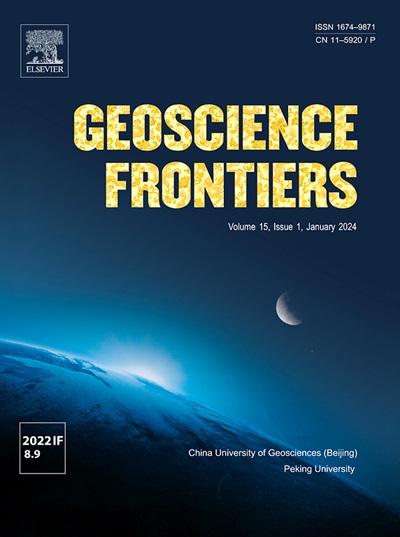Inter-basin groundwater flow in the Ordos Basin: Evidence of environmental isotope and hydrological investigations
IF 8.9
1区 地球科学
Q1 GEOSCIENCES, MULTIDISCIPLINARY
引用次数: 0
Abstract
The Ordos Basin, located in arid and semi-arid region of China, is famous for its abundant groundwater resources and artesian features. The source of groundwater recharge, whether from local precipitation or external sources, has been debated. This study aims to elucidate the groundwater circulation mechanism in the Ordos Basin through scientific expedition, environmental isotope method, and hydrological drilling exploration, providing valuable insights for other artesian basins. Comprehensive analysis indicates that groundwater in the Ordos Basin is recharged by modern precipitation, primarily from high-elevation areas outside the basin. Deep groundwater from these external sources ascends to the aquifer through basement fault zones. Evidence from hydrogen and oxygen isotopes, hydraulic gradients, and water quantities suggests that the Tibetan Plateau is the most potential recharge source. Based on the distribution of Cenozoic basalt and data from seismic observation wells, we propose that leakage water from the Tibetan Plateau rift valley is transported to the Ordos Basin through fast channels, possibly lava tubes, and then upwelling through basement fault zones. This work provides a new perspective on the mechanism of inter-basin groundwater circulation.

鄂尔多斯盆地跨流域地下水流动:环境同位素和水文调查证据
鄂尔多斯盆地位于中国干旱半干旱区,以其丰富的地下水资源和自流地貌而闻名。地下水补给的来源是来自当地降水还是外部来源一直存在争议。本研究旨在通过科学考察、环境同位素方法和水文钻探勘探等手段阐明鄂尔多斯盆地地下水循环机制,为其他自流盆地提供有价值的参考。综合分析表明,鄂尔多斯盆地地下水补给主要来自盆地外高海拔地区的现代降水。来自这些外部水源的深层地下水通过基底断裂带上升到含水层。氢、氧同位素、水力梯度和水量的证据表明,青藏高原是最潜在的补给源。根据新生代玄武岩的分布和地震观测井的资料,我们认为青藏高原裂谷的泄漏水通过快速通道(可能是熔岩管)输送到鄂尔多斯盆地,然后通过基底断裂带上涌。本研究为研究流域间地下水循环机制提供了新的视角。
本文章由计算机程序翻译,如有差异,请以英文原文为准。
求助全文
约1分钟内获得全文
求助全文
来源期刊

Geoscience frontiers
Earth and Planetary Sciences-General Earth and Planetary Sciences
CiteScore
17.80
自引率
3.40%
发文量
147
审稿时长
35 days
期刊介绍:
Geoscience Frontiers (GSF) is the Journal of China University of Geosciences (Beijing) and Peking University. It publishes peer-reviewed research articles and reviews in interdisciplinary fields of Earth and Planetary Sciences. GSF covers various research areas including petrology and geochemistry, lithospheric architecture and mantle dynamics, global tectonics, economic geology and fuel exploration, geophysics, stratigraphy and paleontology, environmental and engineering geology, astrogeology, and the nexus of resources-energy-emissions-climate under Sustainable Development Goals. The journal aims to bridge innovative, provocative, and challenging concepts and models in these fields, providing insights on correlations and evolution.
 求助内容:
求助内容: 应助结果提醒方式:
应助结果提醒方式:


